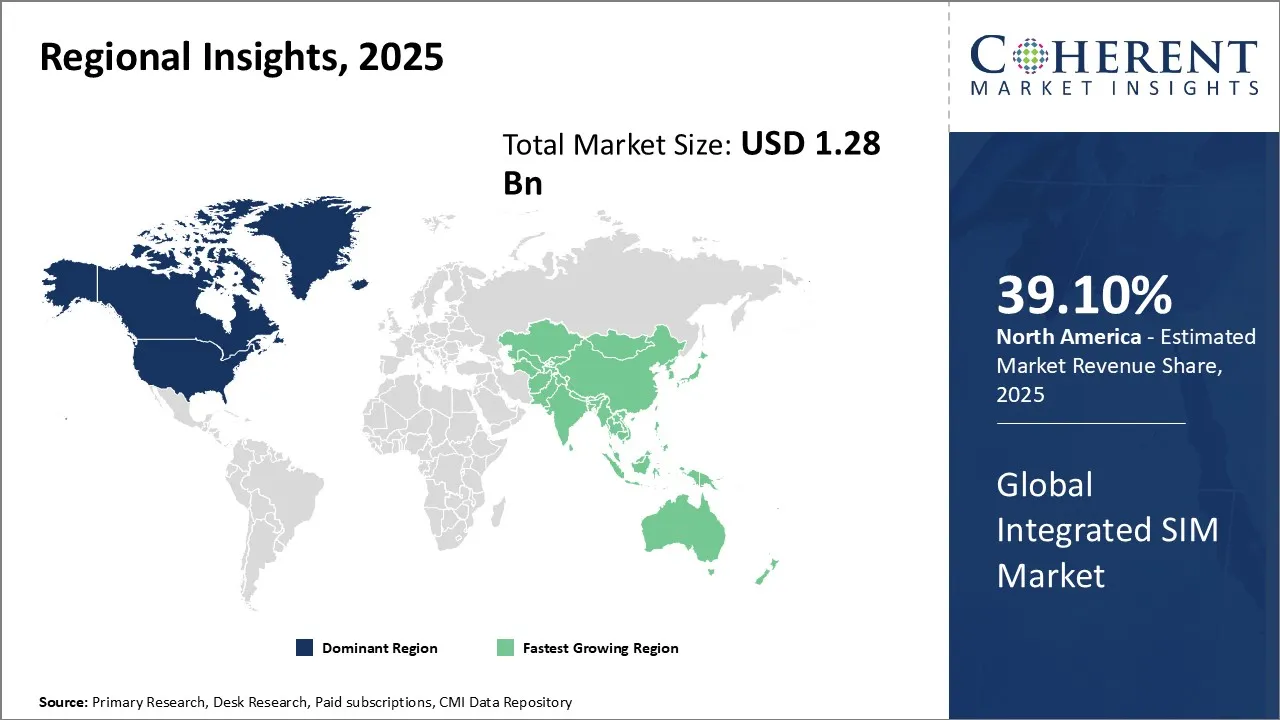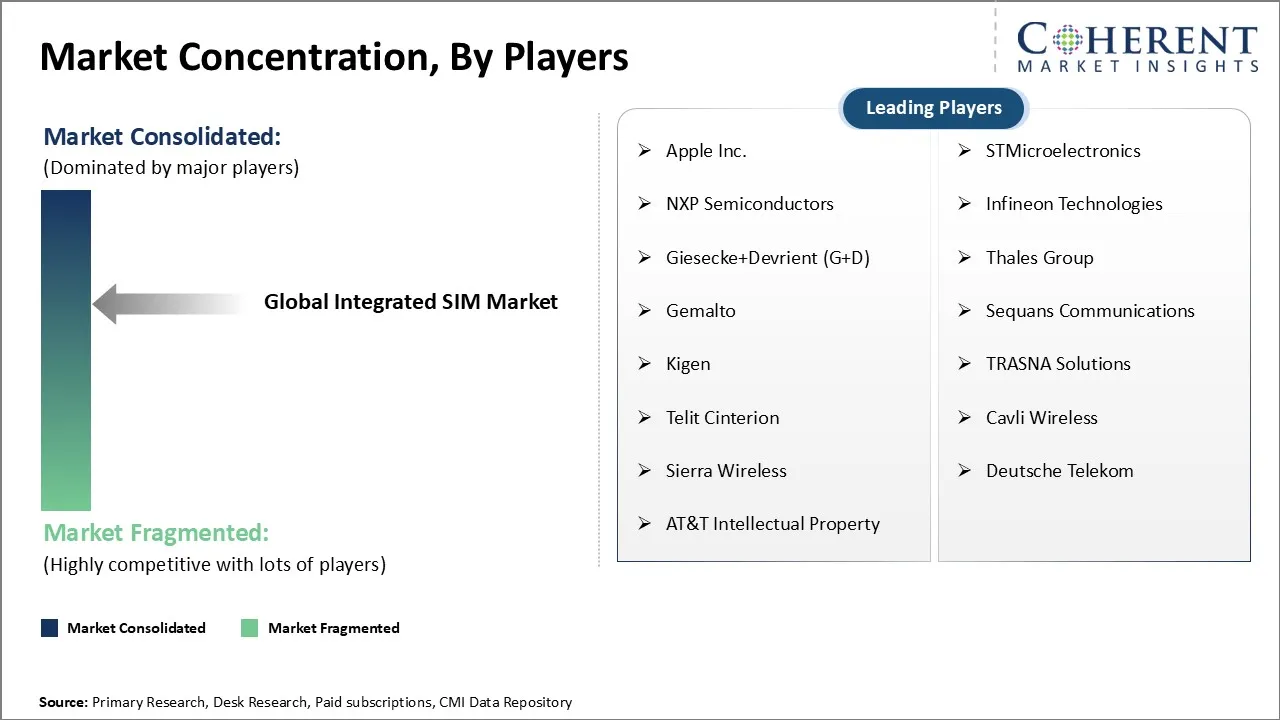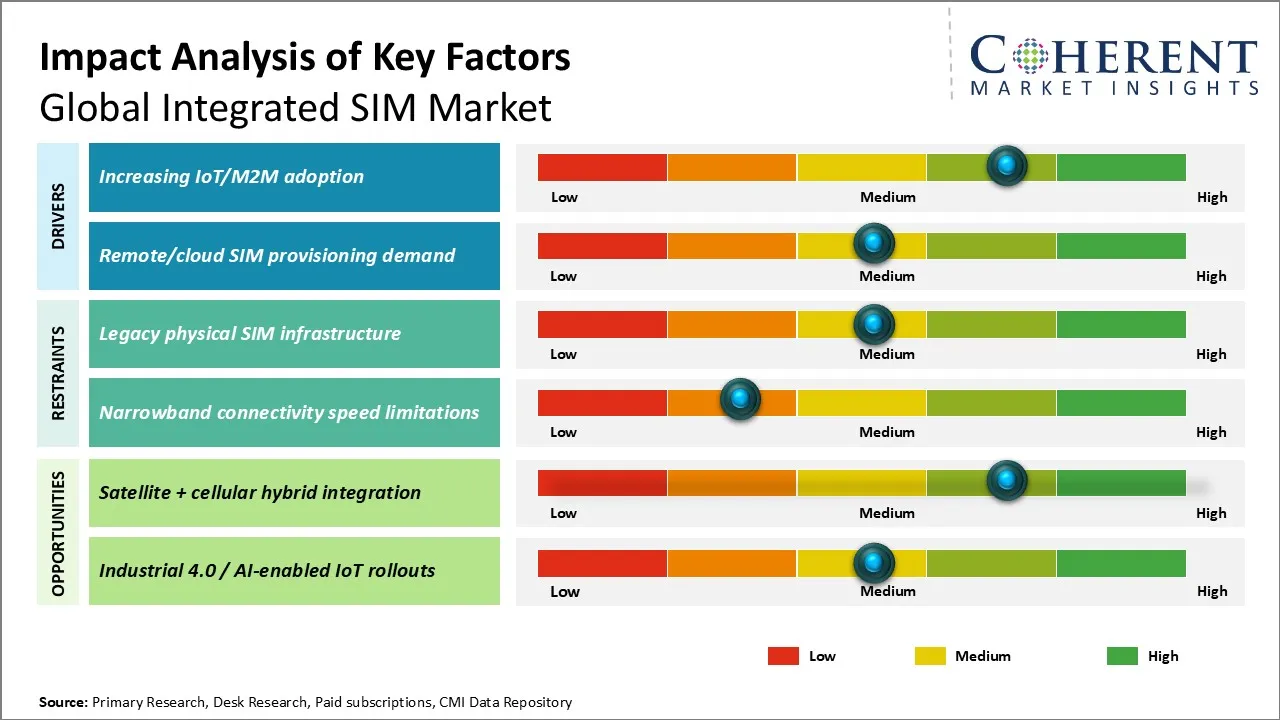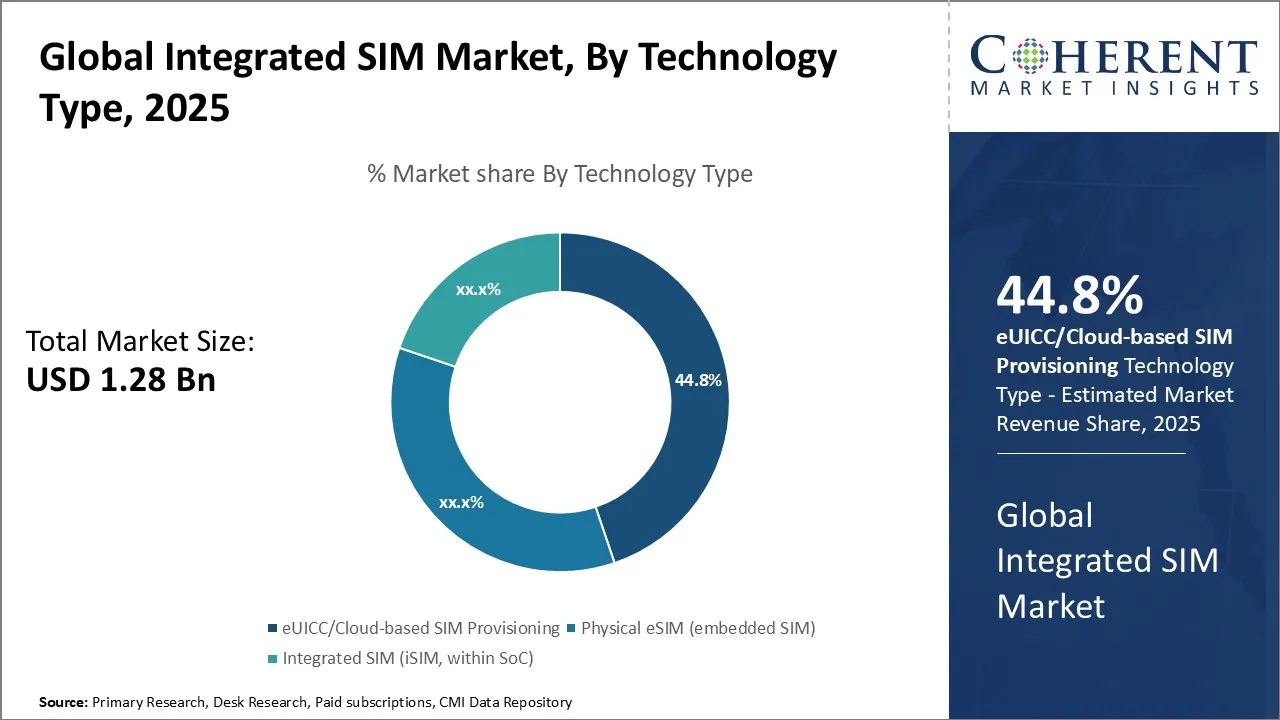Global Integrated SIM Market Size and Forecast – 2025-2032
The Global Integrated SIM Market is estimated to be valued at USD 1.28 Billion in 2025 and is expected to reach USD 3.49 Billion by 2032, exhibiting a compound annual growth rate (CAGR) of 15.4% from 2025 to 2032.
Key Takeaways of the Integrated SIM Market:
- The eUICC/cloud-based SIM provisioning segment leads the market, holding an estimated share of 44. 8% in 2025.
- The M2M/IoT segment leads the market holding an estimated share of 68.1% in 2025.
- North America is estimated to lead the market with a share of 39. 1% in 2025.
- Asia Pacific, holding a share of 27. 9% in 2025, is projected to be the fastest growing region.
Market Overview:
Market trends show a shift towards improved connectivity solutions with integrated SIMs making possible remote provisioning, improved security, and reduced dependency on physical SIM cards. Also, partnerships between telecom providers and device manufacturers are pushing innovation, leading to the integration of embedded SIMs in smartphones, wearables, and automotive sectors.
Current Events and their Impact:
|
Current Events |
Description and its impact |
|
Macroeconomic Shifts in Higher Education Funding |
|
|
Geopolitical and Regulatory Developments |
|
Uncover macros and micros vetted on 75+ parameters: Get instant access to report
Global Integrated SIM Market Insights, by Technology Type, eUICC/Cloud-based SIM Provisioning Leads owing to its Unmatched Flexibility and Scalability
The eUICC, commonly referred to as cloud-based SIM provisioning, leads the global integrated SIM market, holding an estimated share of 44.8% in 2025, due to its revolutionary approach to SIM management. Unlike traditional physical SIM cards, eUICC allows remote provisioning and management of multiple mobile network profiles over the air, providing unparalleled convenience and control for both consumers and enterprises.
A primary driver of growth in the eUICC segment is its ability to enable users to switch carriers seamlessly without the need to physically replace SIM cards. This flexibility is particularly appealing in today’s dynamic mobile environment where customers demand instantaneous connectivity options and network flexibility. For service providers, eUICC technology opens avenues to streamline operations, reduce logistics costs related to physical SIM dispatch, and increase responsiveness to customer needs through swift profile updates.
Furthermore, the rise of IoT deployments has significantly fueled the adoption of eUICC. Large-scale IoT solutions, including smart cities, industrial automation, and asset tracking, benefit greatly from the easy management and scalability of connected devices that eUICC provides. With the potential to remotely provision and modify network credentials on thousands of devices simultaneously, companies are empowered to operate more efficiently and adapt to evolving network conditions or regulatory requirements without costly site visits.
Global Integrated SIM Market Insights, by Application, M2M/IoT Drives the Market Growth through Expanding Connected Ecosystems and Transformative Use Cases
Within the application spectrum of the global integrated SIM market, the Machine-to-Machine (M2M) and Internet of Things (IoT) segment is expected to command the highest share of 68.1% in 2025, propelled by exponential growth in connected devices and smart technologies worldwide. The rise of digital transformation across industries has positioned M2M/IoT as a primary beneficiary of integrated SIM solutions, due to their ability to provide seamless, scalable and secure connectivity crucial for complex, distributed systems.
One of the key factors driving the M2M/IoT segment is the increasing deployment of connected devices across various verticals such as manufacturing, utilities, healthcare, agriculture, and logistics. These sectors rely heavily on reliable cellular connectivity to collect, exchange, and analyze data from sensors, machines, or vehicles in real-time. Integrated SIM technologies, particularly eSIM and iSIM variants, offer an ideal foundation by eliminating the need for manual SIM swaps, simplifying device design, and allowing remote network profile management to meet specific operational requirements.
Additionally, the growing emphasis on Industry 4.0 initiatives, smart infrastructure development, and predictive maintenance is accelerating demand for automated, low-power, and cost-efficient connectivity solutions. Integrated SIMs empower companies to manage large fleets of devices in the field with minimal human intervention, reduce downtime, and optimize performance based on evolving network conditions or geographic movements.
The rising adoption of 5G and LPWAN (Low-Power Wide-Area Network) technologies further supports the expansion of M2M/IoT applications by enabling faster data speeds, lower latency, and extended battery life for devices—attributes that integrated SIMs complement well due to their embedded nature minimizing hardware bulk and power consumption.
Impact of AI on the Integrated SIM Market
Artificial Intelligence (AI) is playing a pivotal role in enhancing the efficiency and intelligence of Integrated SIM (iSIM) and embedded SIM (eSIM) solutions, particularly in large-scale IoT ecosystems. AI enables dynamic connectivity management by allowing devices to automatically switch networks based on performance metrics, coverage, or latency predictions—essential for mission-critical applications like smart grids, logistics, and autonomous vehicles. Additionally, AI-driven analytics enhance subscription lifecycle management, optimizing provisioning, usage prediction, and remote diagnostics, all critical for cloud-based SIM management platforms (eUICC). This is helping telcos and OEMs deliver smarter, lower-cost solutions with reduced need for manual intervention.
Vodafone’s AI-enhanced SIM orchestration system is integrated with Thales’s eSIM platform. Vodafone uses AI to monitor and predict network demand across thousands of connected devices in Europe, automatically provisioning SIM profiles and switching between networks for improved performance and efficiency.
Regional Insights:

To learn more about this report, Download Free Sample
North America Integrated SIM Market Analysis and Trends
North America, holding an estimated share of 39.1% in 2025, holds a dominant position owing to its well-established telecommunications infrastructure and a robust ecosystem of technology innovators and service providers. The region benefits from supportive government policies fostering 5G deployment, IoT expansion, and digital transformation spanning across multiple industries such as automotive, healthcare, and smart cities. Key players including Verizon Communications, AT&T, and Qualcomm actively drive innovation, offering integrated SIM solutions that enhance connectivity and device interoperability.
With the launch of the iPhone 14 (U.S. version), Apple became the first major smartphone vendor to eliminate the physical SIM tray entirely, shifting to eSIM-only support. This bold move accelerated adoption of remote SIM provisioning in North America and pushed carriers like AT&T, T-Mobile, and Verizon to rapidly expand eSIM infrastructure and onboarding experiences.
Asia Pacific Integrated SIM Market Analysis and Trends
The Asia Pacific region, holding an estimated share of 27.9% in 2025, exhibits the fastest growth in the integrated SIM market, propelled by rapid urbanization and an aggressive rollout of 5G networks. Regional trade agreements and growing investments by multinational firms have also enabled efficient market entry and scalability. Notable companies such as Huawei, Gemalto (a Thales company), and NTT Docomo play pivotal roles by developing advanced integrated SIM technologies tailored to regional requirements, boosting user experience and service delivery.
Kigen partnered with Sony Semiconductor Israel and sequencing platforms to launch iSIM-ready chipsets with secure OS and GSMA-compliant provisioning built-in, targeted at low-power NB-IoT devices. This innovation allows OEMs in Asia to manufacture ultra-compact, cost-effective IoT devices without needing discrete SIM slots or soldered SIMs—ideal for smart metering and agriculture in remote Asia Pacific regions.
Integrated SIM Market Outlook for Key Countries
U.S. Integrated SIM Market Analysis and Trends
The U.S. is characterized by cutting-edge technological advancements and a strong presence of major telecom operators like Verizon and AT&T, which actively integrate SIM technology to support large-scale IoT deployments and 5G connectivity. U.S.-based semiconductor companies such as Qualcomm contribute significantly by supplying integrated SIM chipsets, enabling seamless device integration. The country’s regulatory environment encourages innovation, particularly in the automotive and consumer electronics sectors, boosting demand for embedded SIM solutions.
China Integrated SIM Market Analysis and Trends
China continues to lead the integrated SIM market with its massive consumer base and aggressive push towards digitalization under government initiatives like “Made in China 2025.” Telecom giants such as China Mobile, China Telecom, and Huawei collaborate on large-scale integrated SIM implementations, particularly for IoT devices and smart city infrastructure. The country’s strong manufacturing capabilities and investment in 5G infrastructure further catalyze market expansion, making it a hub for both innovation and production.
Japan Integrated SIM Market Analysis and Trends
Japan advances on the back of its sophisticated IoT ecosystem and early adoption of embedded technologies. Companies like NTT Docomo and SoftBank are critical market influencers, leveraging integrated SIM technology to enhance connectivity across automotive telematics, wearable devices, and industrial applications. Government programs promoting smart infrastructure and digital transformation fortify its market position, encouraging innovations that improve device security and user experience.
India Integrated SIM Market Analysis and Trends
India’s rapidly expanding mobile user base and growing IoT sector drive the integrated SIM market forward. Major telecom service providers including Reliance Jio and Bharti Airtel invest heavily to integrate embedded SIM technologies, especially targeting smartphone users and emerging IoT verticals such as agriculture and healthcare. Government initiatives such as Digital India emphasize connectivity expansion, contributing to supportive policy frameworks that incentivize deployment of integrated SIM solutions.
Germany Integrated SIM Market Analysis and Trends
Germany represents a mature European market where integrated SIM adoption is centered around industrial IoT and automotive sectors. Leading telecom operators like Deutsche Telekom and innovative companies such as Infineon Technologies champion integrated SIM technologies to advance connectivity in smart manufacturing and autonomous vehicle development. The country’s stringent data security laws and emphasis on Industry 4.0 encourage development of secure, reliable integrated SIM systems, bolstering its market momentum.
Market Players, Key Development, and Competitive Intelligence:

To learn more about this report, Download Free Sample
Key Developments:
- On June 25, 2025, SGP.32, a GSMA standard for eSIM (embedded SIM) technology, introduced a streamlined eSIM architecture for IoT, enabling global, zero-touch provisioning,thereby reducing complexity and boosting flexibility.
- On June 10, 2025, Kigen, a global leader in eSIM and pioneer of integrated SIM (iSIM) security solutions, announced a strategic investment from the SBI Group, one of Japan’s largest financial services and investment groups.
- In March 2025, u-blox, a global players in positioning and short-range communication technologies, announced the transfer of its cellular IoT module business to Trasna, a leading semiconductor and IoT solutions provider. This strategic move reinforces u-blox’s focus on its core locate business while enabling Trasna to strengthen its IoT connectivity chip-to-cloud offering in the OEM sector.
- In December 2021, Sequans Communications S.A., a provider of cellular IoT connectivity solutions, announced that the industry’s first GSMA-compliant integrated SIM (iUICC) is now Common Criteria certified and available on its second generation LTE-M/NB-IoT chip, Monarch 2.
Top Strategies Followed by Integrated SIM Market Players
- Established industry leaders primarily focus on innovation, heavily investing in research and development (R&D) to create high-performance, next-generation products that meet the growing demands for seamless connectivity and advanced functionalities.
- Thales Group has invested heavily in developing its iSIM Secure Element integrated into System-on-Chip (SoC) designs.
- Mid-level companies in the integrated SIM market pursue more cost-effective strategies designed to appeal to price-sensitive consumers who seek a balance between quality and affordability.
- Cavli Wireless launched the C-Series LTE modules with embedded eSIM support aimed at India, Southeast Asia, and Africa. These modules offer affordable cellular IoT connectivity with bundled data plans, allowing cost-conscious OEMs to scale their deployments without incurring high hardware or SIM provisioning costs.
- Small-scale participants in the global integrated SIM industry carve out niche segments by emphasizing specialized features or innovative product offerings tailored to specific applications or regional needs.
- 1oT, a small but agile eSIM connectivity provider based in Estonia, has built a custom eSIM management platform tailored for startups and SMEs in logistics and micromobility. Their "1oT Terminal" allows clients to manage multi-carrier eSIMs across thousands of devices via a unified dashboard.
Market Report Scope
Integrated SIM Market Report Coverage
| Report Coverage | Details | ||
|---|---|---|---|
| Base Year: | 2024 | Market Size in 2025: | USD 1.28 Bn |
| Historical Data for: | 2020 To 2024 | Forecast Period: | 2025 To 2032 |
| Forecast Period 2025 to 2032 CAGR: | 15.4% | 2032 Value Projection: | USD 3.49 Bn |
| Geographies covered: |
|
||
| Segments covered: |
|
||
| Companies covered: |
Apple Inc., STMicroelectronics, NXP Semiconductors, Infineon Technologies, Giesecke+Devrient (G+D), Thales Group, Gemalto, Sequans Communications, Kigen, TRASNA Solutions, Telit Cinterion, Cavli Wireless, Sierra Wireless, Deutsche Telekom, and AT&T Intellectual Property |
||
| Growth Drivers: |
|
||
| Restraints & Challenges: |
|
||
Uncover macros and micros vetted on 75+ parameters: Get instant access to report
Market Dynamics

To learn more about this report, Download Free Sample
Global Integrated SIM Market Driver - Increasing IoT/M2M Adoption
As organizations increasingly deploy connected devices—ranging from smart meters, wearable technology, autonomous vehicles, to industrial automation systems—the need for reliable, secure, and easily manageable connectivity has become paramount. Integrated SIMs offer greater flexibility and durability compared to traditional SIM cards, enabling seamless device activation and remote provisioning, which is critical in large-scale IoT deployments where physical SIM replacements are impractical. Moreover, the ability of integrated SIMs to support multiple network operators and adapt to different regions eliminates connectivity barriers, facilitating global scalability for IoT solutions. This enhanced connectivity capability not only improves device uptime and operational efficiency but also reduces logistics and maintenance costs, making integrated SIMs an indispensable component in accelerating IoT and M2M adoption worldwide.
Global Integrated SIM Market Opportunity: Satellite and Cellular Hybrid Integration
As demand for ubiquitous and reliable connectivity intensifies, especially in remote, rural, and underserved areas, the hybrid solution combining satellite communication with traditional cellular networks offers unparalleled advantages. Integrated SIMs capable of seamlessly switching between cellular networks and satellite links ensure continuous connectivity regardless of location or network availability. This capability is particularly vital for industries such as maritime, aviation, logistics, emergency services, and outdoor recreational sectors, where maintaining constant communication is critical. Deutsche Telekom and 1NCE (its IoT connectivity partner) expanded their NB-IoT and LTE-M coverage to over 150 countries, offering eSIM-based global M2M connectivity for smart meters, logistics, and industrial sensors. In 2023, Kigen partnered with Skylo Technologies, a non-terrestrial network (NTN) provider, to develop iSIM-enabled devices that combine terrestrial LTE and satellite IoT connectivity. These hybrid solutions allow devices—such as ocean buoys, remote agricultural sensors, and wildlife trackers—to switch seamlessly between cellular networks and satellite coverage
Furthermore, the rising proliferation of Internet of Things (IoT) devices necessitates resilient and fail-safe connectivity options; a hybrid satellite-cellular integrated SIM can provide dynamic network selection, optimizing performance and coverage while mitigating downtime. Technological advancements in low Earth orbit (LEO) satellite constellations, coupled with expanding 5G cellular networks, create an enabling ecosystem for hybrid integrated SIM solutions.
Analyst Opinion (Expert Opinion):
- Manufacturing, utilities, and logistics are driving robust demand for iSIM/eSIM solutions, as enterprises prioritize scalable, remotely manageable connectivity for vast networks of sensors and machines. The ability to provision SIMs over-the-air and reduce physical handling aligns perfectly with Industry 4.0 and predictive maintenance initiatives.
- Smartphones, wearables, and tablets continue to lead in unit volumes, especially as OEMs like Apple and Samsung push eSIM adoption. However, this segment sees high price sensitivity and tight margins, making it more attractive for large-scale players than mid-tier vendors.
- Demand from connected cars, EVs, and smart mobility services is accelerating, driven by regulatory mandates and V2X communication needs. Automakers are increasingly adopting iSIM for embedded connectivity, allowing for real-time diagnostics, infotainment updates, and future autonomous capabilities—positioning this as a high-growth, high-value vertical.
Market Segmentation
- Technology Type Insights (Revenue, USD Bn, 2020 - 2032)
-
- eUICC/Cloud-based SIM Provisioning
- Physical eSIM (embedded SIM)
- Integrated SIM (iSIM, within SoC)
- Application Insights (Revenue, USD Bn, 2020 - 2032)
-
- M2M/IoT
- Consumer Electronics
- Automotive
- Other
- Regional Insights (Revenue, USD Bn, 2020 - 2032)
- North America
- U.S.
- Canada
- Latin America
- Brazil
- Argentina
- Mexico
- Rest of Latin America
- Europe
- Germany
- U.K.
- Spain
- France
- Italy
- Russia
- Rest of Europe
- Asia Pacific
- China
- India
- Japan
- Australia
- South Korea
- ASEAN
- Rest of Asia Pacific
- Middle East
- GCC Countries
- Israel
- Rest of Middle East
- Africa
- South Africa
- North Africa
- Central Africa
- North America
- Key Players Insights
- Apple Inc.
- STMicroelectronics
- NXP Semiconductors
- Infineon Technologies
- Giesecke+Devrient (G+D)
- Thales Group
- Gemalto
- Sequans Communications
- Kigen
- TRASNA Solutions
- Telit Cinterion
- Cavli Wireless
- Sierra Wireless
- Deutsche Telekom
- AT&T Intellectual Property
Sources
Primary Research Interviews:
Stakeholders:
- Semiconductor Manufacturers (e.g., Chipset R&D Heads, Product Architects)
- IoT Module OEMs and Suppliers (e.g., Design Engineers, Procurement Managers)
- Telecom Operators & MNOs (e.g., Network Architects, SIM Strategy Leads)
- Automotive Connectivity Integrators (e.g., Vehicle Telematics Experts)
- Smart Device Manufacturers (e.g., Smartphone and Wearable Product Managers)
- Industrial IoT Platform Providers (e.g., Deployment Engineers, Integration Leads)
Databases:
- Global Telecom Technology Index (GTTI)
- International Mobile Communications DataHub
- Asia-Pacific IoT Deployment Registry
- Connected Systems Deployment Atlas (CSDA)
Magazines:
- Connected Tech Weekly
- Smart Mobility Review
- IoT Infrastructure Journal
- NextGen Telecom Insights
Journals:
- Journal of Embedded Connectivity & Systems
- IoT & M2M Communications Review
- Journal of Advanced Network Technologies
- Global Telecommunications Research Bulletin
Newspapers:
- The Connectivity Chronicle
- IoT Business Times
- The Global Network Observer
- Tech & Mobility Daily
Associations:
- International Association of Mobile Infrastructure (IAMI)
- Smart SIM Technology Alliance (SSTA)
- Global Embedded Systems Federation (GESF)
- IoT Standards Consortium (IoT-SC)
- Next-Generation Telecom Operators Council (NGTOC)
Public Domain Sources:
- International Telecommunication Union (ITU)
- United Nations Centre for Trade Facilitation and e-Business (UN/CEFACT)
- World Economic Forum – Connectivity and Data Platforms
- OECD Digital Economy Outlook
- Global IoT Open Data Exchange (GIODE)
Proprietary Elements:
- CMI Data Analytics Tool, Proprietary CMI Existing Repository of information for last 8 years
Share
Share
About Author
Monica Shevgan has 9+ years of experience in market research and business consulting driving client-centric product delivery of the Information and Communication Technology (ICT) team, enhancing client experiences, and shaping business strategy for optimal outcomes. Passionate about client success.
Missing comfort of reading report in your local language? Find your preferred language :
Transform your Strategy with Exclusive Trending Reports :
Frequently Asked Questions
EXISTING CLIENTELE
Joining thousands of companies around the world committed to making the Excellent Business Solutions.
View All Our Clients


